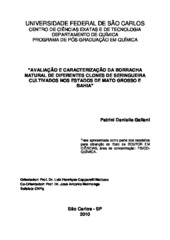Avaliação e caracterização da borracha natural de diferentes clones de seringueira cultivados nos estados de Mato Grosso e Bahia
Abstract
Natural rubber (NR) is a basic raw material used in the manufacture of a wide range of rubber goods. Usually both quality and productivity levels of Brazilian NR are lower than the imported NR. This is due to a lack of research projects which would particularly deal with the characterization and evaluation of the NR properties. For this purpose this paper summarized the study on the following items: the evaluation of both inter- and intraclonal variations; the effect of coagulation method on the NR properties; the evaluation of the coagulation method and the conditions of the bowls used for latex extraction within the NR technological properties; and the characterization of GEBs employing phosphoric acid, sulfate of hydroxylamine, and EDTA. The examination on NR was carried out through the routine analysis of such material applying DSC, TG, FTIR, GPC techniques, and also minerals analysis. In the investigation on both inter- and intraclonal influences, the results had shown statistical distinct behaviors for the NR properties of the following clones: FX 3864, GT 1, RRIM 600, PR 255 and FX 3864-PMB, including significant variations among clones and extractions. For the tire industries the essay in the PRI is the most important procedure, since it indicates an inference on the resistance to thermooxidative degradation of NR. Except for the clone PR 255, the average PRI values of all investigated clones was lower than the minimum value required by Brazilian Standard NBR 11597, and therefore it was identified a low-quality rubber of such clones. The linear regression analysis indicated that the genetic characteristics of each clone are responsible for the different results concerning the variations in environmental conditions as temperature and precipitation. The variants examined on the NR properties can be considered as the effects of factors such as climate, the origin of the clone, frequency of bleeding, soil, stimulation, seasonal, processing, and non-rubber compound, among others. In the investigation on the effect of coagulation method in the NR technological properties, the results have shown that coagulated latex samples with EDTA presented the highest PRI values for all investigated clones. Treatments with different antioxidant substances demonstrated an increase in PRI values of fresh latex samples (with no ammonia addition), for the concentrations of 0,001% and 0,01% with antioxidant substances (B and D) e (A, C, D, and A+D), in that order. In the review of the evaluation of the coagulation method and the conditions of the bowls used to extract latex from clone RRIM 600, it was verified that rubber samples obtained from the chemical coagulation had the highest PRI values and the samples from natural coagulation of the latex (it was used recycled bowls) presented PRI values lower than the standard rates required by the industries. In the findings of the characterization of the GEBs, treatments with phosphoric acid and sulfate of hydroxylamine contributed to an increase in PRI as well as a reduction in VR, respectively.
